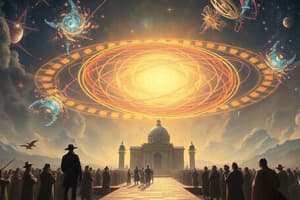Podcast
Questions and Answers
What was the purpose of the concave lens?
What was the purpose of the concave lens?
- To magnify images (correct)
- To study stars
- To observe Jupiter's moons
- To measure air pressure
What idea did Nicolaus Copernicus propose?
What idea did Nicolaus Copernicus propose?
The sun was the center of the universe
Tycho Brahe observed supernovas and comets, proving the heavens did not change.
Tycho Brahe observed supernovas and comets, proving the heavens did not change.
False (B)
Who made the compound microscope more efficient?
Who made the compound microscope more efficient?
___ studied magnetism and helped navigators find their way.
___ studied magnetism and helped navigators find their way.
What did Galileo invent that allowed him to view stars and Jupiter's moons?
What did Galileo invent that allowed him to view stars and Jupiter's moons?
What kind of orbits did Kepler discover planets underwent?
What kind of orbits did Kepler discover planets underwent?
Galileo observed that Jupiter's moons orbited the Earth.
Galileo observed that Jupiter's moons orbited the Earth.
What did Galileo's observations of sunspots prove?
What did Galileo's observations of sunspots prove?
What were the theories regarding ocean tides?
What were the theories regarding ocean tides?
What did the Law of Falling Bodies disprove?
What did the Law of Falling Bodies disprove?
Who invented analytical geometry?
Who invented analytical geometry?
Who designed the barometer?
Who designed the barometer?
What did Isaac Newton split white light into?
What did Isaac Newton split white light into?
Galileo proved that sound traveled faster than light.
Galileo proved that sound traveled faster than light.
Who contributed to the development of calculus?
Who contributed to the development of calculus?
What inspired Isaac Newton's Law of Gravity?
What inspired Isaac Newton's Law of Gravity?
What did Isaac Newton publish in 1687?
What did Isaac Newton publish in 1687?
Who predicted the movement of a comet in 1705?
Who predicted the movement of a comet in 1705?
Flashcards are hidden until you start studying
Study Notes
Inventions of the Scientific Revolution
- Concave lens developed in 1451 was instrumental in magnifying images for observations.
The Heliocentric Model
- In 1514, Nicolaus Copernicus proposed the heliocentric model, positioning the sun at the center of the universe.
Astronomical Discoveries
- Tycho Brahe's observations from 1572-1577 revealed supernovas and comets, challenging the belief that the heavens were immutable.
Advancements in Microscopy
- The compound microscope was made more efficient by Galileo around 1590, enhancing the study of tiny organisms and structures.
Early Studies of Magnetism
- Research on magnetism, dating back to 1600, influenced navigation methods; initiated by Aristotle and later embraced by ancient Chinese scholars.
The Telescope
- Between 1600-1610, Galileo improved the telescope, allowing groundbreaking visions of celestial bodies including the stars and Jupiter's moons.
Kepler's Discoveries
- Johannes Kepler, from 1605-1609, discovered that planets followed elliptical orbits rather than circular paths, deviating from classical beliefs.
Observations of Jupiter's Moons
- In 1610, Galileo discovered that Jupiter's moons orbited Jupiter itself, further supporting heliocentrism.
Sunspots and Celestial Imperfections
- Galilean observations of sunspots in 1610 provided evidence that the celestial realm was imperfect, opposing the notion of heavenly perfection.
Ocean Tides
- Galileo, Kepler, and Newton contributed theories regarding the causes of ocean tides, with Newton providing a comprehensive explanation.
Law of Falling Bodies
- Established in 1634 through experimentation, Galileo demonstrated that all bodies fall at the same rate regardless of their weight.
Analytical Geometry
- Introduced by René Descartes in 1637, it combined algebra and geometry, later influencing Newton's development of calculus.
Invention of the Barometer
- In 1643, Evangelista Torricelli invented the barometer under Galileo's mentorship, pioneering air pressure measurement techniques.
Light Spectrum Discovery
- Isaac Newton's work in 1665 led to the discovery that white light can be separated into various colors, known as the light spectrum.
Speed of Light
- Galileo's experiments in 1676 supported the idea that light travels faster than sound.
Development of Calculus
- Between 1684 and 1693, Isaac Newton contributed to the creation of calculus, elucidating the principles of movement.
Law of Gravity
- The Law of Gravity, developed by Newton in 1686, was famously inspired by the anecdote of an apple falling on his head.
Newton's Three Laws of Motion
- Published in 1687, these laws describe the fundamental principles of motion governing the universe.
Prediction of Comet Orbits
- In 1705, Edmund Halley accurately predicted the trajectories of comets through the application of Newton's laws of motion.
Studying That Suits You
Use AI to generate personalized quizzes and flashcards to suit your learning preferences.




